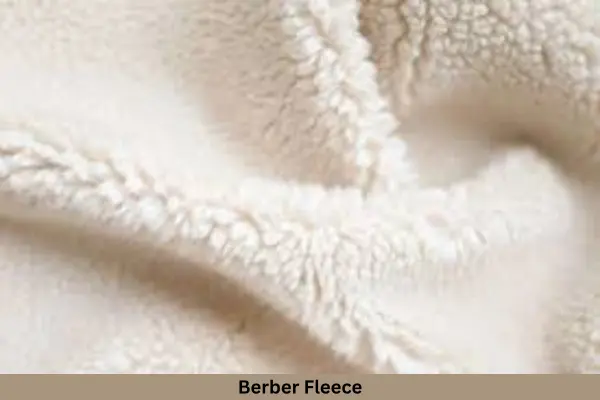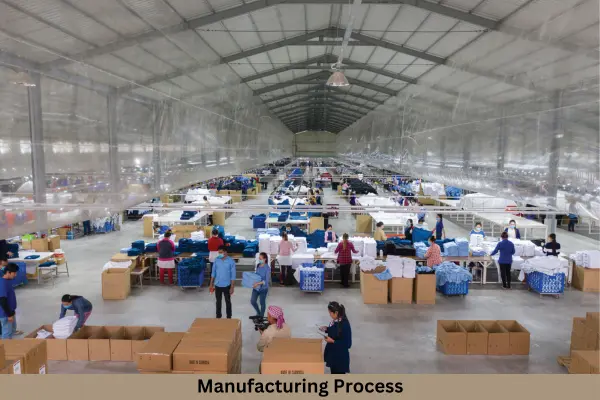Difference Between Berber Fleece vs Sherpa Fabric
| Comparison | Berber Fleece | Sherpa Fabric |
|---|---|---|
| Also Known As | Teddy fleece, High-pile fleece. | Faux-sheepskin fleece, Lamb fleece. |
| Manufacturing Process | Knit structure, brushed high-pile surface. | Knit base with brushed loops for a plush feel. |
| Appearance | Soft, curly, and nubby texture. | Soft, fluffy, and smooth wool-like texture. |
| GSM Range | 220–350 GSM. | 200–320 GSM. |
| Composition Range | 100% Polyester or Poly-cotton blend. | 100% Polyester or Poly-acrylic blend. |
| Construction Range | Warp or circular knit, brushed finish. | Circular knit with brushed back. |
| Functionality | W/R, Anti-pilling, TPU coating. | AC, TPU, W/R, Moisture-wicking. |
| Thread Density Range | 200T–380T | 190T–360T. |
| Count Variations | 75D/36F, 150D/96F | 75D/72F, 150D/144F |
| Breathability | Moderate | High |
| Heat Retention Abilities | High | Moderate to High |
| Stretchability | Moderate (2-way stretch) | Low to moderate |
| Prone to Pilling/Bubbling | Moderate | Low (due to shorter fibers) |
| First Produced (Country/Year) | USA, 1970s | France, 19th Century |
| Biggest Exporter (Quantity) | China (Over 150,000 MT annually) | China (Over 120,000 MT annually) |
| Recommended Washing Temperature | 30°C (cold wash) | 30°C (cold wash) |
| Applications | Jackets, blankets, lining, upholstery | Hoodies, jackets, blankets, baby products |
| Durability | High (resistant to wear and tear) | Moderate (soft but less abrasion-resistant) |
Berber fleece and sherpa fabric are popular choices for warmth and comfort, but they have distinct differences. In this article, I will break down their characteristics, uses, and technical details to help you decide which fabric fits your needs best.
Table of Contents
What is Berber Fleece?
Berber fleece is a synthetic fabric known for its soft, nubby texture resembling natural wool. It is made from 100% polyester or a polyester blend.

This fabric offers excellent heat retention and moisture-wicking properties, making it ideal for outdoor wear and winter garments.
- GSM Range: 250-400 GSM
- Composition: 100% Polyester or Poly-Blend
- Thread Density: 200T-350T
- Appearance: Thick, looped texture
What is Sherpa Fabric?
Sherpa fabric mimics the look and feel of sheepskin, with a soft, fluffy pile.

It is commonly used as a lining for jackets and blankets due to its warmth and plushness.
- GSM Range: 220-380 GSM
- Composition: 100% Polyester or Poly-Cotton Blend
- Thread Density: 180T-320T
- Appearance: Soft, fuzzy surface with a smooth back
Manufacturing Process

- Berber Fleece: Made through a knitting process using synthetic fibers, then brushed to create a textured, looped surface.
- Sherpa Fabric: Produced by knitting polyester or a blend, followed by a napping process to form a thick pile on one side.
Which Fabric to Choose?
- For Outdoor Wear: Berber fleece is best for jackets and gloves due to its moisture-wicking ability.
- For Home Comfort: Sherpa fabric is ideal for blankets and linings because of its softness and warmth.
Conclusion
Both Berber fleece and sherpa fabric have unique advantages. Berber offers durability and moisture-wicking properties, while sherpa provides superior warmth and softness.
FAQs
Which fabric is warmer, Berber or Sherpa?
Sherpa is warmer due to its thick, fluffy pile.
Does Berber fleece pill easily?
No, it has high pilling resistance.
Is Sherpa fabric breathable?
It has moderate breathability compared to Berber fleece.
Can I machine wash both fabrics?
Yes, but Berber fleece should be line-dried to prevent damage.
Which fabric is better for activewear?
Berber fleece is better due to its moisture-wicking properties.
